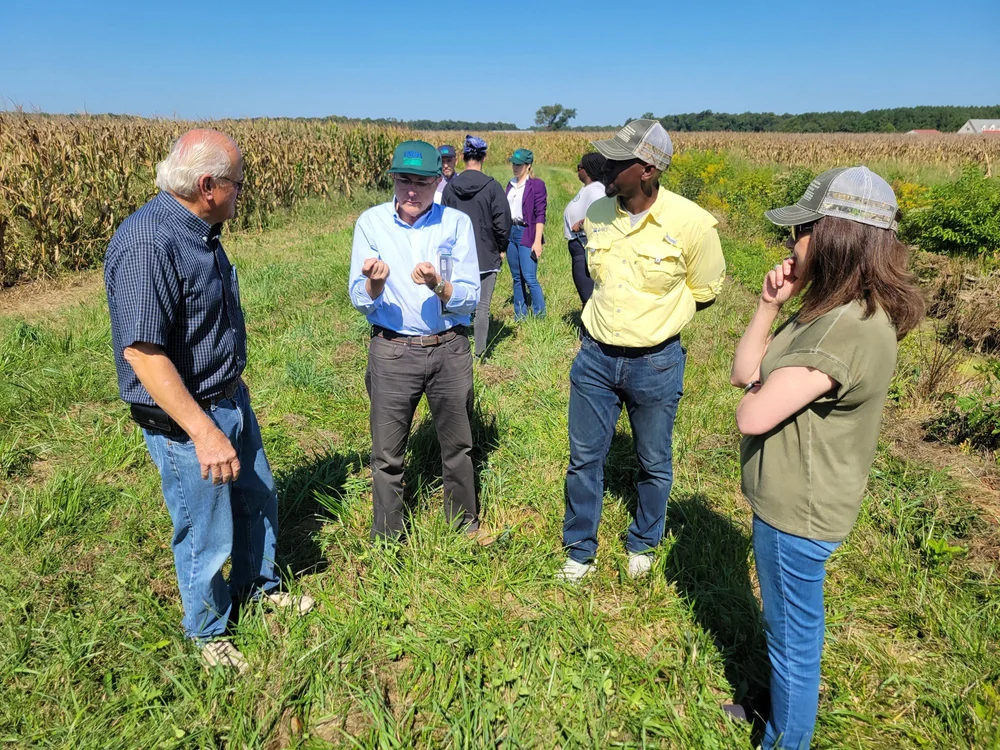Accessing capital and finding financial resources are significant barriers and challenges that farmers face. Understanding the different types of funding pools available is key to helping start, expand, or sustain a farming operation.�Below are resources and tools to help...

Accessing capital and finding financial resources are significant barriers and challenges that farmers face. Understanding the different types of funding pools available is key to helping start, expand, or sustain a farming operation.�
Below are resources and tools to help farmers navigate the many pathways that can be taken to find funding for farming operations and to identify the funding stream that works best for the business model and goals.
Federal Funding
Getting into agricultural production can be risky and challenging, so the United States Department of Agriculture (USDA) offers programs to assist farmers. The USDA consists of fifteen agencies, and the most common agencies that farmers work with for funding resources are the Farm Service Agency, the Natural Resources Conservation District, and Rural Development. It is important to contact your local USDA Service Center to learn about specific programs that your farming operation can qualify for and to meet the local staff at USDA agencies. Each agency plays a specific role within USDA and has their own funding programs.
Farm Service Agency
Gaining access to USDA funding resources begins with registering with the Farm Service Agency (FSA) to obtain a farm number. FSA provides operating farm loans, disaster assistance, safety net, and conservation programs and is the go-to agency for many USDA records. With a farm number you can apply for FSA farm loans and USDA programs. You will also be able to elect FSA officials to help prioritize programs in your county. You do not have to own property to participate in FSA programs. If your operation is incorporated or an entity, FSA may need proof of your signature authority and legal ability to sign contracts with USDA. Depending on what you raise or grow, filing an acreage report each season can ensure you�re eligible for many programs and allows you to vote in county FSA elections.
If you are new to working with USDA, an FSA team member will help register your farm. Reach out to the local Arizona FSA office here for guidance on how to begin the process of applying for eligible funding programs.
Natural Resources Conservation District�
The Natural Resource Conservation District (NRCS) offers a number of funding opportunities and technical assistance programs to help increase the productivity of your farming operations and conserve natural resources. Several NRCS programs include:
Environmental Quality Incentive Program (EQIP)
EQIP provides technical and financial assistance to farmers to help address natural resource concerns like improving water and air quality, increasing soil health, reducing soil erosion, fostering wildlife habitat, and mitigating against drought and weather volatility. EQIP can fund projects like high tunnels and transitioning to organic practices using a tailored conservation plan.
Conservation Stewardship Program (CSP)
CSP helps with enhancing current conservation practices on agricultural lands. For farmers wanting to increase crop resiliency, implement a multi-species cover crop plan, develop wildlife habitat, or improve the conditions of the land, CSP is a useful program to look into for financial assistance.�
Conservation Innovation Grants (CIG)
CIG is a program that supports the development of new tools, approaches, practices, and technologies to advance natural resource conservation on private lands. CIG has supported projects ranging from the implementation of automated sprinkler systems that save farmers money and water, to the development of tools that quantify ecosystem services provided by the farm to generate a new income stream for producers.
Contact your local Arizona NRCS service center here and schedule a time to meet with your county�s agent.� An NRCS team member will ask about your goals for your farming operation and can help you develop a conservation plan and file an application for the wide range of NRCS conservation programs.�
Rural Development�
The USDA Rural Development Agency provides financial resources and support for rural communities, residents, and businesses. Specifically, the Agriculture Innovation Center Program provides technical and business development assistance to agricultural producers to help them develop and market value-added agricultural products. Rural Development Energy Programs can also help with funding renewable energy projects on the ranch or farm. Programs such as the Rural Energy for America Program provides agricultural producers with guaranteed loan financing and grant funding for the purchase, installation, and construction of renewable energy systems and energy efficiency improvements.�

USDA Tools
A useful resource for identifying USDA farm loans and funding opportunities to finance your business is the farm loan discovery tool. This resource explains eligibility requirements for a variety of farm loan options and can help get started on application forms.�
Another handy tool is the�"Find Your Local Arizona Dashboard."�Here farmers can view�local farming news from USDA, cattle and other commodity prices, weather data, and contact information for local USDA service centers, coordinators, and state offices. You can also find USDA program information, drought data, and how to sign up for email updates.
For beginning farmers, USDA developed several tools and resources on how to start and fund a farm located here and here. For small and mid-size producers, USDA created this page to outline valuable resources and program information about access to capital, land management and conservation practices, managing risk, finding local markets, and other educational resources. For urban farmers, USDA compiled resources on this page to help growers on small acreage and in urban settings navigate available USDA resources.�
Grants��
Grants provide capital to help farmers finance their operations without incurring debt. Many federal, state, local, and private grants exist, such as the City of Phoenix�s grant programs through their Resilient Food System Program and Food Grants.�

Some larger-scale grants, like USDA federal grants, can be time-consuming to apply for and resources exist to assist farmers with the process. Local First Arizona�s Arizona Economic Recovery Center (AZERC) helps farmers find, apply for, and win federal, state, and foundation grants. The Center helps identify potential grants to fit specific farming needs, as well as provides support services such as free grant writers and project facilitators. The AZERC Newsletter is a useful resource that comes out weekly and highlights many funding opportunities; subscribe to it here.
Becoming familiar with current USDA initiatives and programs can help identify specific areas for additional sources of grant funding. For example, if a farmer wants to open a processing center, under the Meat and Poultry Supply Chain initiative there are grant funding opportunities (and technical assistance) to help with the costs. For farmers ready to expand their marketing channels, the USDA�s Agricultural Marketing Service administers many grant programs to assist producers with developing domestic and international marketing opportunities for food, fiber, and specialty crops. The Farmers Market Promotion Program provides grant funding to help increase community access and the availability of locally and regionally produced products.
Subscribing to USDA newsletters and services is a great way to stay current with grant funding opportunities. Also, other agriculture and food system related organizations will offer their own grant funding opportunities so subscribing to their newsletters or following their social media accounts is a great way to be notified of upcoming grant cycles.�
Private Capital�
Private financial resources can be an important form of funding, particularly for beginning farmers and underserved farmers. New farmers may not be eligible for traditional loans that often require physical collateral or three years of production records, and obtaining funding through private capital can bridge that gap. Years of documented discriminatory practices within the USDA and FSA involving denial of farm loans and USDA programs to Black and minority farmers have prevented them access to financial resources. Private organizations such as Potlikker Capital formed specifically to support farmers of color through accessible, charitable integrated capital funds while using an holistic approach to serve farmers. Other private entities like MAD Agriculture focus on supporting regenerative agriculture producers and offer quick fund releases and flexible repayment terms.�
Tribal Communities and Indian Country
Tribal organizations dedicated to serving Native and Indigenous farmers with funding opportunities and other tools can be valuable resources. The Indigenous Food and Agriculture Initiative, The Intertribal Agriculture Council, and The Native American Agriculture Fund provide funding opportunities, business services, technical support, and agricultural education to Native producers and Tribal communities. Other tribal organizations include:�
First Nations Development Institute
Tribal Food Sovereignty Advancement Initiative | NCAI
The USDA Rural Development Tribal Relations office also contains information on Tribal-specific programs, programs with set-aside Tribal funding, and other useful information for Native Americans and Tribal communities.

Local Resources
Local sources of funding are useful places to look for capital and sometimes the application process is more simple and less competitive. Local municipalities or counties may offer funding through their own programs. For small businesses in select counties, Local First Arizona is helping administer micro-loan programs that offer loans in smaller amounts to local businesses to help them stay competitive in a continuously changing economy.�
Local programs like Purchase Local AZ can help build and expand economic opportunity for local and underserved producers. The $15 million funding stream is part of a three-year grant cycle (2023-2026) whose purpose is to maintain and improve food and agricultural supply chain resilient. The program provides farmers with an opportunity to gain access to more local and diverse market channels such as food bank programs, schools, and organizations that reach underserved communities. Arizona producers can apply here.�
The Arizona Department of Agriculture (AZDA) was recently awarded funding through USDA�s Resilient Food Systems Infrastructure Program (RFSI). Through the Arizona RFSI program, approximately $3.17 million will be available for competitive subaward grants to build resilience in the middle of the food supply chain for Arizona-based food and farm businesses. Two grant pools� equipment-only grants and infrastructure grants� will work to expand capacity for the aggregation, processing, manufacturing, storing, transporting, wholesaling, and distribution of local food products including specialty crops, dairy, grains for human consumption, aquaculture, and other food products, excluding meat and poultry. AZDA is currently seeking input from local stakeholders and producers to help determine priorities for this program.�

Farm Income�
One of the best ways to fund your farm is to increase your income. And one of the best assets that a farmer has is their story. Relating the story of why you are a farmer and how your food is lovingly grown and brought to customers is extremely important. Not only does this explain why customers may be paying a premium for your quality farm products, but it also connects people to where their food grows and their local farmer. Understand which audience and customer base will best relate to your farm products and story. Use social media, farmers markets, and the appropriate distribution channel for your business model. Below are several funding programs aimed at expanding market and distribution channels to increase farm income:�
Agricultural Marketing Service (AMS) and Food and Nutrition Service (FNS) can help reach consumers in new ways and open additional revenue streams.
The Women, Infants, Children (WIC) Farmers� Market Nutrition Program and Seniors Farmers Market Nutrition Program issues coupons for eligible foods from state-approved farmers, farmers' markets, or roadside stands. Contact your state for eligibility and information on how to accept WIC as payment when selling products directly to consumers.
Double-Up Food Bucks is a program that allows current Supplemental Nutrition Assistance Program (SNAP) participants an opportunity to receive additional fruits and vegetables and are accepted at participating farmers markets and grocery stores.
Farm Storage Facility Loans (FSA) provide low-interest loans to build, upgrade, or purchase permanent or portable facilities to store commodities, including fruit and vegetable cold storage, washing, packing, and handling buildings and equipment.
Farmers Market Promotion Program (FMPP) funds projects that develop, coordinate and expand direct producer-to-consumer markets like farmers markets. Agricultural businesses and cooperatives are among the eligible entities.










